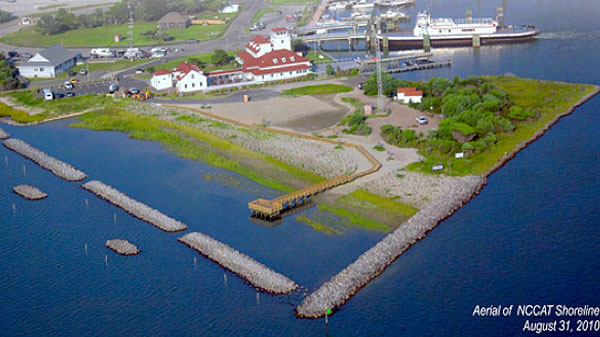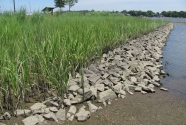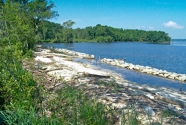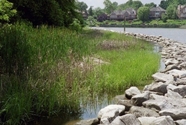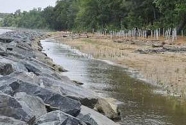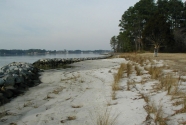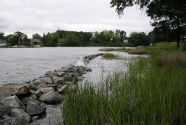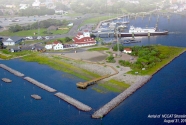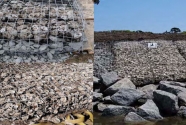By Orrin H. Pilkey,* Rob Young, Norma Longo,* and Andy Coburn; Program for the Study of Developed Shorelines / Western Carolina University, March 1, 2012
*Nicholas School of the Environment, Duke University.
EXECUTIVE SUMMARY
In response to the significant detrimental environmental impacts caused by traditional erosion control structures such as bulkheads and revetments along estuarine and riparian shorelines, many environmental groups, state resource management agencies and federal resource management agencies now advocate an approach known as “Living Shorelines” that embraces the use of natural habitat elements such as indigenous vegetation to stabilize and protect eroding shorelines.
On its website, NOAA defines the term “Living Shoreline” as a more natural bank stabilization technique that uses plants, sand, and limited use of rock to provide shoreline protection and maintain valuable habitat. It describes “Living Shoreline” projects as those that use a variety of structural and organic materials, such as wetland plants, submerged aquatic vegetation, oyster reefs, coir fiber logs, sand fill, and stone.
A survey of “Living Shorelines” along Gulf and East coast estuarine shorelines, however, reveals that a growing number of projects classified as a “Living Shoreline” are relying more on massive hard stabilization with less emphasis on natural stabilization or the development of a significant habitat component, as was the original intent of early “Living Shoreline” projects.
A survey of recent projects dubbed “Living Shorelines” on the US East and Gulf Coasts indicates that there is a wide range in the design, degree of stabilization, amount of habitat creation, and monitoring. Some are used to protect private property, and some are designed to reduce the erosion on the margins of existing wetlands. In short, the term Living Shoreline is being used to describe everything from well-constructed, vegetative stabilization projects to massive rock revetments where a small planting of marsh grasses seems to be an afterthought.
We are concerned that the use of massive hard engineering structures in the deployment of some of these so called “Living Shoreline” projects will cause long-term environmental degradation, provide a false sense of accomplishment, and shift the focus away from trying to maintain the most natural estuarine shoreline feasible. There is a need for advocates of “Living Shorelines” to more precisely define and regulate this term so it is not misused simply to allow more unnecessary and damaging hard stabilization of estuarine shorelines.
We urge broad reconsideration of the use of large-scale hard stabilization for “Living Shorelines” and a renewed scientific effort to evaluate the cumulative impacts of all existing structures (bulkheads and Living Shorelines) on natural and physical processes and ecosystems.
With the likelihood that tens of millions of dollars will be spent over the next decade building tens of miles of new “Living Shoreline” projects, we need a better perspective on the long-term fate of all “Living Shorelines”, as our estuaries, and the ecosystems they nurture, respond to increasing rates of sea level rise in the coming years.
The Theory behind Living Shorelines
Shoreline erosion is a natural process in most coastal environments, and estuarine shorelines are no exception. Coastal landowners, however, typically view any loss of land as undesirable, which leads to demands for erosion control structures such as seawalls, revetments and bulkheads. These structures do not allow the marshes and beaches to move inland in response to sea level rise and will eventually result in the loss of shoreline environments such as fringing marshes and sandy beaches.
In a well-intentioned response to the proliferation of traditional erosion control structures along estuarine and riparian shorelines, many government agencies and conservation organizations now advocate a concept known as “Living Shorelines” that uses natural habitat elements like marsh grasses and oyster reefs to stabilize and protect shorelines. NOAA defines the term “Living Shoreline” as a more natural bank stabilization technique that uses plants, sand, and limited use of rock and other materials to provide shoreline protection and maintain valuable habitat.
All Living Shorelines are said to have one fundamental element in common: a reliance on natural methods for shoreline erosion control that do not sever existing connections between riparian, intertidal, estuarine and aquatic areas essential for water quality, ecosystem services and habitat values.
While the goal of “Living Shorelines” – to reduce the growing dependence on traditional shoreline erosion control/shoreline stabilization structures that damage shoreline habitat in favor of more natural approaches – is commendable, an examination of “Living Shorelines” across the US indicates that we need an immediate reassessment of what “limited” use of rock means, where the various design elements are appropriate, and where they are not.
Problems with Living Shorelines that Utilize Structural Stabilization
We are not naïve. We recognize the threat to our estuaries posed by bulkheads and other traditional shoreline stabilization techniques. Clearly, coastal managers and policy-makers need to address the long-term loss to intertidal habitat that is occurring along estuarine shorelines as a result of the rush to stop coastal erosion and property loss. In North Carolina alone, permits are being issued to allow from 20 to 30 miles of estuarine shoreline to be stabilized each year.
… We are concerned that the use of massive hard engineering structures in the deployment of some of these so called “Living Shoreline” projects will cause long-term environmental degradation, provide a false sense of accomplishment, and shift the focus away from trying to maintain the most natural estuarine shoreline feasible.
—Pilkey, Young, Longo, Coburn
What started out as a laudable effort to substitute natural vegetation for hard erosion control structures often now devolves into designs that embrace, rather than discourage, the use of rock sills, revetments and breakwaters where private property owners are more interested in protection than ecosystem enhancement. In many locations, rocks have replaced significant portions of sandy estuarine beaches and subaqueous bottom habitat.
A proposal in Alabama for “restoration” of the coastal environment following the Deepwater Horizon oil spill, for example, includes surrounding an entire marsh island with large, segmented breakwaters and back filling with sediment. It is hard to see how many of these projects maintain the “natural connections between riparian, intertidal, estuarine and aquatic areas.”
Many “Living Shoreline” projects are described as “environmental restoration” projects. Let’s be very clear, structurally stabilized Living Shorelines and shorelines where marsh grass has been planted but never previously existed do not meet the definition of environmental restoration as defined by the Society for Ecological Restoration International and should not be considered environmental restoration. True ecological restoration returns an ecosystem to its original trajectory. Dam removal on rivers is a good example. Shoreline stabilization utilizing rock sills, breakwaters, or similar structures is an attempt to thwart that trajectory, regardless of what is planted behind the structure.
The question is how do advocates for “Living Shorelines” avoid the inevitable tendency for the original goals of habitat enhancement to be abused by overly aggressive permit applicants, engineers, and property owners? How do we ensure that future Living Shoreline projects are, in fact, preferable to the bulkheads they are often designed to replace?
Recommendations:
• Clearly, we need to reexamine the management of estuarine shorelines in the same way that many states have examined ocean shorelines. This includes the development of realistic setbacks and an understanding that allowing the construction of bulkheads, revetments, breakwaters and other hard structures causes great environmental harm and ecosystem degradation. Estuarine shorelines are dynamic, just as ocean shorelines are. We urge all parties to redouble their efforts to reduce the rate at which this nation’s estuarine shorelines are being walled off from the rest of the estuary.
• “Living Shorelines” need to be precisely defined. This definition should include specific, quantifiable development standards that establish what “limited” use of structural materials actually means.
• “Living Shorelines” that rely on hard stabilization structures should be avoided or minimized wherever possible. If structures are used, they should be temporary, biodegradable or easily removable. Living Shorelines that include massive, traditional erosion control structures should not be classified as “Living Shorelines” simply because they contain a vegetative component.
• Objective, science-based monitoring of short- and long-term biological, geological and physical impacts of “Living Shorelines” (as well as traditional bulkheads) is needed to answer questions concerning long-term benefits and function, sedimentation rates, storm responses, impact on erosion rates, impact on nutrient contribution, and loss of sandy beach ecosystems.
• Where a structural stabilization component is used, alternative materials, such as oyster shell bags where appropriate, should be used to reduce the impacts and construction access challenges associated with the use of stone sills, revetments and breakwaters.
• Fiber or coir logs have been placed against undercut banks and trees to act as a medium for plant propagation and provide temporary protection for incipient marshes. They increase slope stability, encourage growth of fibrous roots and decay naturally within 5 years in the marine environment.
• Additional research needs to be carried out to assess the impacts to nearby ecosystems of introducing any type of non-native structural control (e.g. rocks, oyster shells) into areas where those substrates would not normally occur.
• Regulatory incentives and general permits that allow and promote the ongoing, heavy stabilization of the estuarine shoreline with bulkheads and seawalls need to be abolished.
Conclusion
The term “Living Shorelines” is frequently overused. There is no precise and universally accepted definition used by advocates of this shoreline stabilization strategy. This results in many projects that rely heavily on engineering structures, rather than the biological components for shoreline stabilization. Until a measurable definition of “Living Shoreline” projects is made, there is real danger that the term will be used to justify stabilization projects that are just as damaging to estuarine shorelines as the traditional shoreline stabilization techniques they are meant to replace.
Developing strict criteria for what a “Living Shoreline” should be is critical as some states move to the availability of general permits for the construction of “Living Shorelines” based largely on the assumption that they are environmentally friendly. Many governmental entities are using rock structures to reduce erosion on natural, marsh shorelines. Is this a “Living Shoreline” as they are often called? And how will these structures impact the dynamic estuary as sea level rises?
“Living Shorelines” that incorporate traditional erosion control structures are not restoration projects and should not be advertised as such.
APPENDIX
The above images gallery, provides examples of ‘Living Shorelines.’

